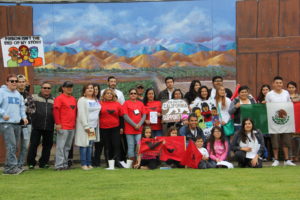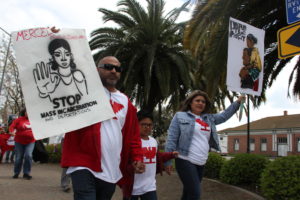By Hannah Esqueda
Images by Alyssa Castro
MERCED, Calif. — Amid a toxic political climate and federal targeting of undocumented populations, Merced residents gathered recently to celebrate the legacy of one of California’s most famous civil rights leaders and his work to protect the vulnerable.
Dozens of families, activists and young people came out to participate in Merced’s third annual Cesar Chavez march; walking down the city’s Martin Luther King Boulevard while holding signs displaying their support for undocumented rights and the continued protection of farm workers.
“We’re very happy with the event,” said Jesse Ornelas, a Chair of the Cesar Chavez March Committee and member of the local chapter of the Brown Berets. “We got the community to come out and talk about issues that were relevant to South Merced and the farmworker community in general in this area.”
After three years, the event is also becoming more well-known in the community and Ornelas said he heard from many people wanting to get involved in the days and weeks leading up to the march this year.
“People are starting to expect it in our community,” he said. “Now things are getting a little smoother and community organizations are wanting to team up with us and be a part of the event.”
“It feels good to see how this thing is becoming a city tradition now,” he continued.
This year’s march was themed “The Struggle is One,” a message organizers like Ornelas say was meant to remind residents that even in the past, real change was only possible when the people worked together towards a common goal.
Just as Cesar Chavez and Dolores Huerta worked to organize Filipino and Mexican farm workers last century, organizers said it’s up to the community to come together at the same table again and protect the undocumented and others being targeted by new federal policies.

“[These populations] they’re much more under attack now that we’re under this current administration,” said Michelle Xiong, youth organizer with Faith in the Valley Merced.
“There are still a lot of problems that farmworkers face, but they’re highlighted less or swept under the rug and ignored because it’s not pretty. So our community needs to stand up and see it’s truly a community issue,” she continued.
For younger residents, the event’s historical context is important since some are not as familiar with Cesar Chavez and his legacy, said Alice Herrera, 18.
“I’ve heard of [Chavez] before but wasn’t 100 percent certain of [his work],” she said. “At the event, I did learn a bit more about him.”
Herrera said she was also motivated to come out in support of the community as any organizing effort in Merced should be recognized and celebrated.
“I feel like not only this march but every march in Merced is important because we have such a small community,” she said. “It was empowering to see that people care.”
While marchers were drawn to the event for various reasons, many of the participants were able to find common ground, said Crissy Gallardo, community organizer with Faith in the Valley Merced.
“I saw a lot more conversations [this year] around different issues. People in the community were aware that all oppressed peoples, from immigrants to the LGBT community, to those that were formerly incarcerated; all of those different [groups] are going to have to fight together [to make a change],” she said.

That community sentiment was reinforced in the Community Circle event hosted by Building Healthy Communities (BHC) Merced directly following the Cesar Chavez march. There, participants were able to sample Hmong, Mexican and African-American food while watching local youth and cultural dancers perform on stage at the Merced Senior Center.
The celebration helped highlight the common theme of peaceful protest each of the three cultures has shared in the past, as well as expose Merced families to the reality of their neighbors, Xiong said.
“We were lifting up the idea that communities of color can come together and learn from each other, as has been the case historically,” she said. “Offering a hand across the table or lending a helping hand shows that we are stronger together.”
Organizers also made a point of having all Community Circle presentations spoken in English, Spanish and Hmong, as a reminder that every culture and spoken language has a place in the community.
“It’s necessary to examine that status quo and remind it that we are watching and participating,” Xiong said. “Communities of color are affected by these [political decisions] and they want to do something about it. They deserve to be included.”
 Translate
Translate
